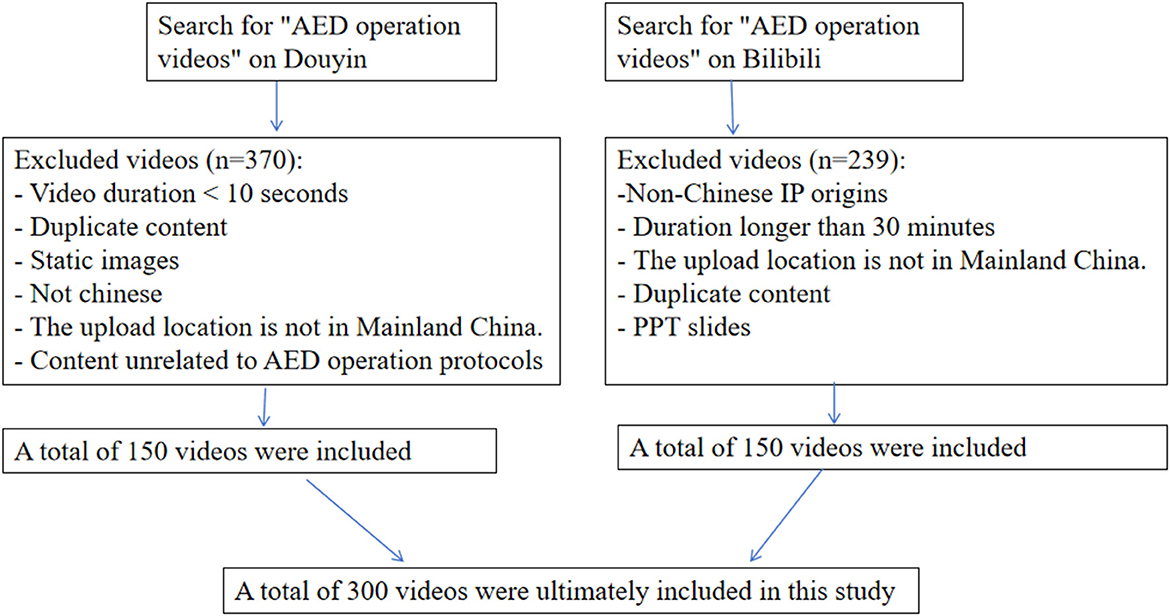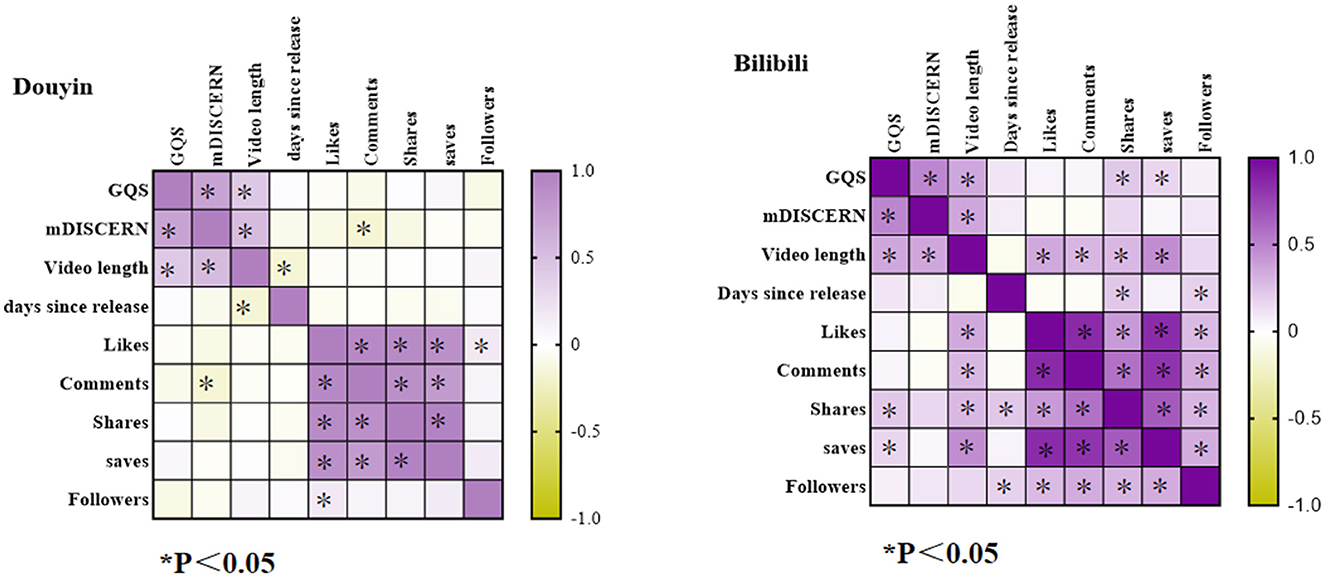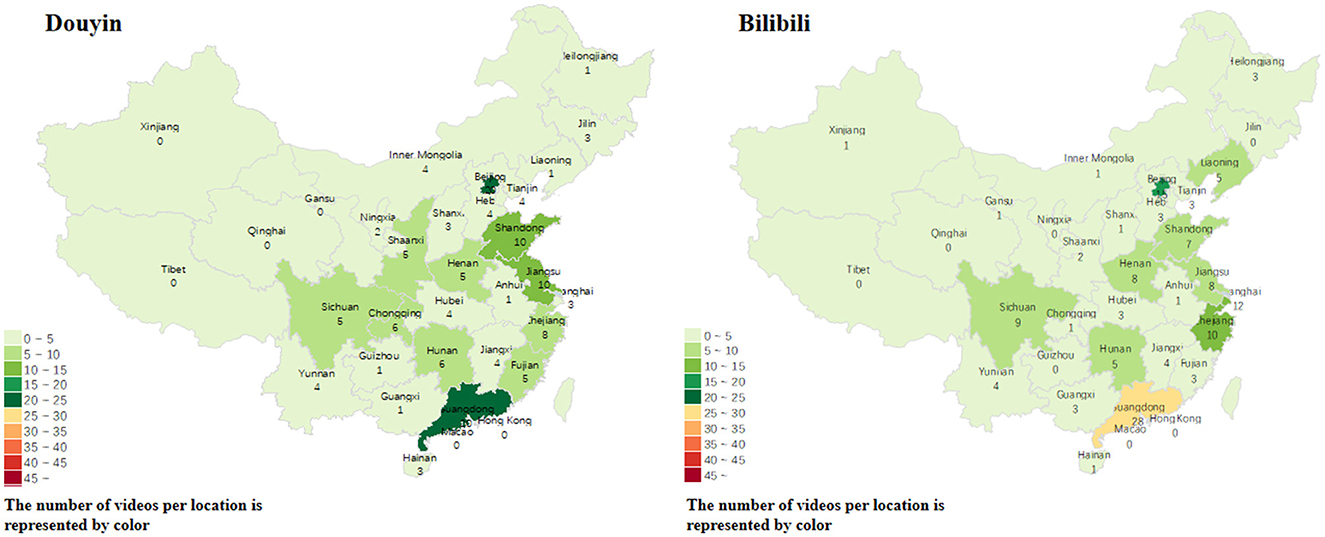- 1Department of Emergency Medicine, Southwest Hospital of Third Military Medical University, Chongqing, China
- 2Department of Endocrinology, Hospital of Chongqing University, Chongqing, China
Background: Sudden cardiac arrest remains a significant medical and societal challenge, claiming millions of lives annually. Early defibrillation is one of the few known interventions that can improve survival rates for cardiac arrest victims. Therefore, increasing bystander awareness of emergency care is crucial. The public predominantly gains first-aid knowledge from platforms such as TikTok and Bilibili, which may vary significantly in terms of the quality and trustworthiness of educational content.
Objective: This study aims to evaluate the quality and reliability of the top 150 videos related to the operation of automated external defibrillators (AEDs) on the Douyin and Bilibili video platforms.
Methods: On February 1, 2025, we conducted a search using the keyword “AED operation” on Douyin and Bilibili. We included the first 150 videos that met the inclusion criteria. These videos were classified by content and source. The quality and reliability of the videos were evaluated using the Global Quality Score and the modified DISCERN tool. Furthermore, we examined the relationships between video quality and various factors, including video duration, publication time, and metrics, such as likes, comments, shares, and follower count.
Results: Our analysis revealed considerable variation in the quality of AED-related videos across Douyin and Bilibili. Videos produced by medical institutions or professional medical influencers were more scientifically grounded, practical, and authoritative. Additionally, the study showed that longer videos tended to be of higher quality, and increased video interaction (e.g., likes, comments) helped expand videos' reach, boosting public confidence in emergency care.
1 Introduction
Sudden cardiac death is still a significant medical and societal challenge, causing millions of deaths annually (1). Among the interventions for cardiac arrest, defibrillation is one of the few known to improve survival rates (2). Early bystander cardiopulmonary resuscitation (CPR) and automated external defibrillator (AED) use have been proven to enhance survival rates (3, 4). In China, however, the rate of bystander CPR for out-of-hospital cardiac arrest is only 20.3%, with AED use by bystanders at just 0.1% (5). The current situation regarding bystander intervention is concerning. Research indicates that in China, CPR training plays a crucial role in increasing bystanders' willingness to perform CPR, enhancing awareness of AEDs, and improving knowledge of cardiac arrest emergency care (6).
With the rapid growth of internet technology, short-video platforms have become a critical channel for the public to acquire health knowledge, especially for first-aid skills and disease prevention. China's internet user base is nearing 1.1 billion, with a penetration rate of 78%.1 Among the content being viewed, health-related videos are among the most popular. For example, on Douyin, the most searched-for diseases are common ailments, such as the flu, pneumonia, diabetes, hemorrhoids, rhinitis, dysmenorrhea, autumn diarrhea, mycoplasma pneumonia, rotavirus, and cardiovascular diseases. The video on Douyin tagged with “flu” has reached 6.5 billion views, while “AED operation”–related videos have accumulated 1 billion views.
The integration of social media and public health education has broken traditional barriers, enabling more convenient access to medical support and critical resources (7, 8). These videos play a vital role in health promotion, disease prevention, and managing public health crises (9). While short-video platforms have enhanced the spread of health knowledge, they have also introduced problems such as fragmented, homogeneous, and entertainment-focused content that may lack professionalism or propagate misleading information. This has sparked considerable concern about the accuracy and quality of the information presented in these videos (10).
This study involved analyzing 300 AED-related videos from Douyin and Bilibili, using the Global Quality Score (GQS) and modified DISCERN (mDISCERN) tools to assess both their content quality and reliability. This is the first study in China to analyze emergency rescue knowledge videos on short-video platforms.
2 Materials and methods
2.1 Search strategy and data collection
On February 1, 2025, we searched for videos related to “Automated External Defibrillator (AED) operation” on Douyin (Chinese version, v33.1.0) and Bilibili (Chinese version, v8.34.0). To avoid bias caused by personalized recommendations, newly registered accounts were used on both platforms. The search was restricted to videos published before 2025. After screening 909 videos, those shorter than 10 s or longer than 30 min, videos that duplicate content, videos presented as images or in PowerPoint presentation format containing theoretical knowledge, non-Chinese videos, videos with content unrelated to AEDs, and videos with Internet Protocol (IP) addresses located outside China were excluded. Finally, the top 150 eligible videos from each platform were selected. Due to privacy settings or copyright restrictions on some videos on Douyin and Bilibili, downloading was not always feasible; therefore, all collected videos were organized and stored within grouped folders under the respective accounts.
The video search and screening process, illustrating the steps and numbers involved in keyword retrieval, initial screening, duplicate removal, and final inclusion of videos from Douyin and Bilibili used in this study, is shown in Figure 1.
2.2 Video classification
We recorded the video's publishing IP address, likes, comments, shares, followers, account certification status, video duration, release date, and days since release (as of January 1, 2025). We also categorized the videos based on their source (e.g., medical official, non-medical official, professional medical influencer, other influencers, the public, and commercial advertisements) and content type (e.g., professional science communication, non-professional science communication, news reports, and advertisements).
2.3 Video evaluation
To evaluate the quality and reliability of the videos, we employed the GQS and the mDISCERN tools, both of which are commonly used for assessing the credibility and quality of health-related video content (11, 12). The GQS was originally developed to assess the educational value, practicality, and quality of web-based health content and was later adapted for video evaluation. It is now widely used in methodology frameworks for analyzing health-related content, especially in the field of cardiology, on platforms such as YouTube (13), where it is used to evaluate the quality and reliability of patient education videos, such as in the education of pacemaker patients and physicians (14, 15). The mDISCERN tool is a simplified version of the original DISCERN, designed to quickly evaluate the reliability of health information videos on social media platforms such as YouTube and TikTok (12). Both tools use scoring scales to rate video quality and reliability, as shown in the Supplemental materials S1–S3. Two professional emergency medicine doctors, Hu and Wang, fully understood the detailed scoring criteria for GQS and mDISCERN. They independently evaluated the videos, with any discrepancies resolved through consensus with a third reviewer, Luo.
2.4 Statistical analysis
Statistical analyses and data visualization were performed using GraphPad Prism version 10.1 (Chinese version). After assessing the normality of the data, categorical variables were expressed as percentages, while non-normally distributed data were presented as medians with interquartile ranges. Differences in non-normally distributed variables between groups were compared using the Mann–Whitney U-test. To further quantify the magnitude of these differences, Cohen's d effect size was calculated to aid in result interpretation. Spearman's correlation coefficient (r) was used to assess the relationships between variables. The strength of correlation was interpreted based on the following criteria for r values ranging from −1 to 1: strong correlation: 0.8 ≤ r < 1.0, moderate correlation: 0.5 ≤ r < 0.8, weak correlation: 0.3 ≤ r < 0.5, and very weak or no correlation: 0.0 ≤ r < 0.3.
3 Results
3.1 Video-related information
We collected 300 AED-related videos from Douyin and Bilibili published between 2019 and 2024. On Douyin, the most common sources were non-medical official videos, 50 (33.3%), followed by other field influencers, 24 (16%); professional medical influencers, 23 (15.3%); the public, 20 (13.3%); medical official accounts, 19 (12.7%); and commercial ads, 14 (9.3%). On Bilibili, there were no medical official videos, and the most common sources were other field influencers, 58 (38.7%), followed by professional medical influencers, 31 (20.7%); the public, 30 (20%); non-medical official videos, 17 (11.3%); and commercial ads, 14 (9.3%).
Douyin videos were primarily non-professional science communication, 73 (48.7%), followed by professional science communication, 43 (28.7%); news reports, 21 (14%); and advertisements, 13 (8.7%). On Bilibili, non-professional science communication made up the majority, 94 (62.7%), followed by professional science communication, 35 (23.3%); advertisements, 13 (8.7%); and news reports, 8 (5.3%).
The numbers of likes, comments, shares, and followers on Douyin were all significantly higher than those on Bilibili (all p < 0.05). In contrast, videos on Bilibili had longer durations and had been published for a longer period compared to those on Douyin (both p < 0.0001). These differences were statistically significant (Table 1).
3.2 Comparison of overall video quality scores between Douyin and Bilibili
The median GQS was 3 for Douyin and 4 for Bilibili (p = 0.059). The median mDISCERN score was 3 for both platforms (p = 0.3675). Although the overall video quality on Bilibili was higher than that on Douyin, the differences in video quality and reliability between the two platforms were not statistically significant (Figure 2).
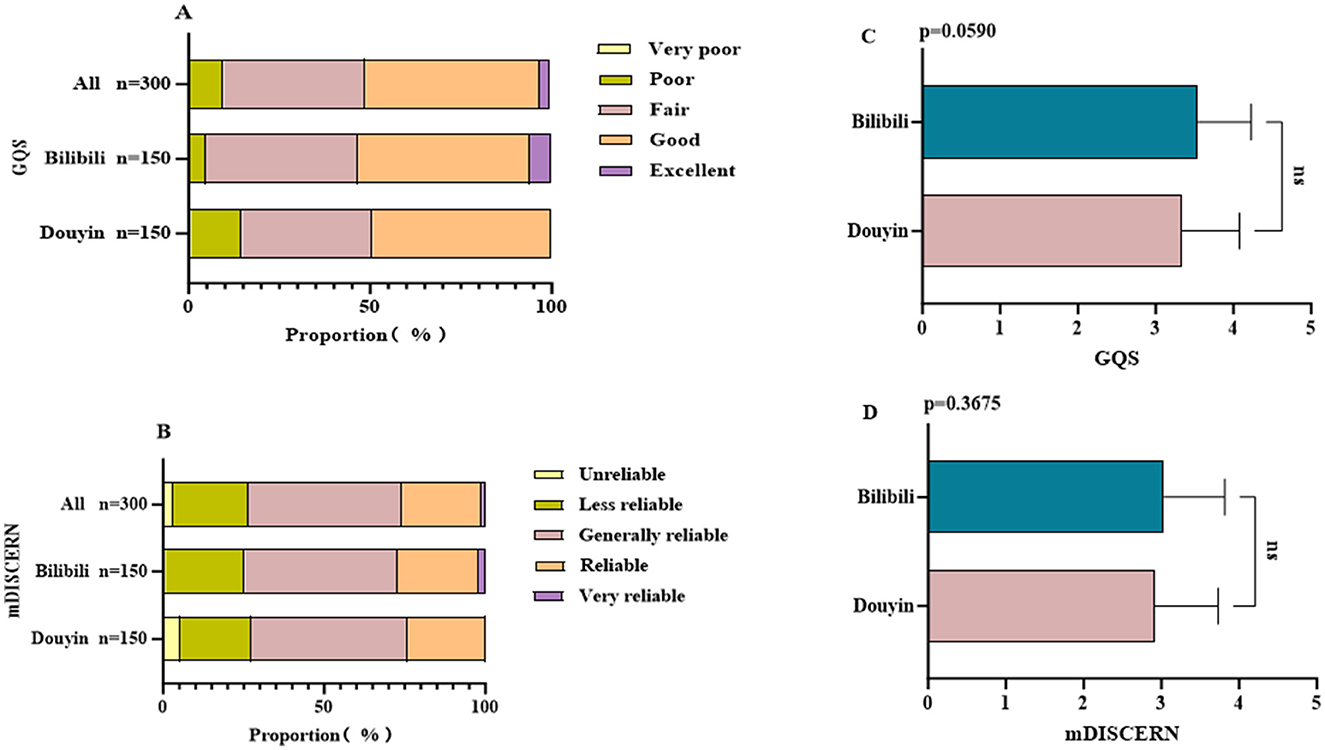
Figure 2. Panels A and B show the percentage distribution of GQS and mDISCERN scores for videos on Douyin and Bilibili, respectively; panels C and D compare the overall quality scores (GQS).
3.3 Comparison of video quality and reliability by source and content
In terms of video sources, videos produced by professional medical creators demonstrated the highest quality (p = 0.0031; Figure 3A). Videos released by official medical institutions exhibited higher quality and reliability compared to those from non-official sources (p < 0.05; Figures 3A, B). Regarding video content, professional science communication videos on both platforms showed the highest quality and reliability (p < 0.05; Figures 3C, D).
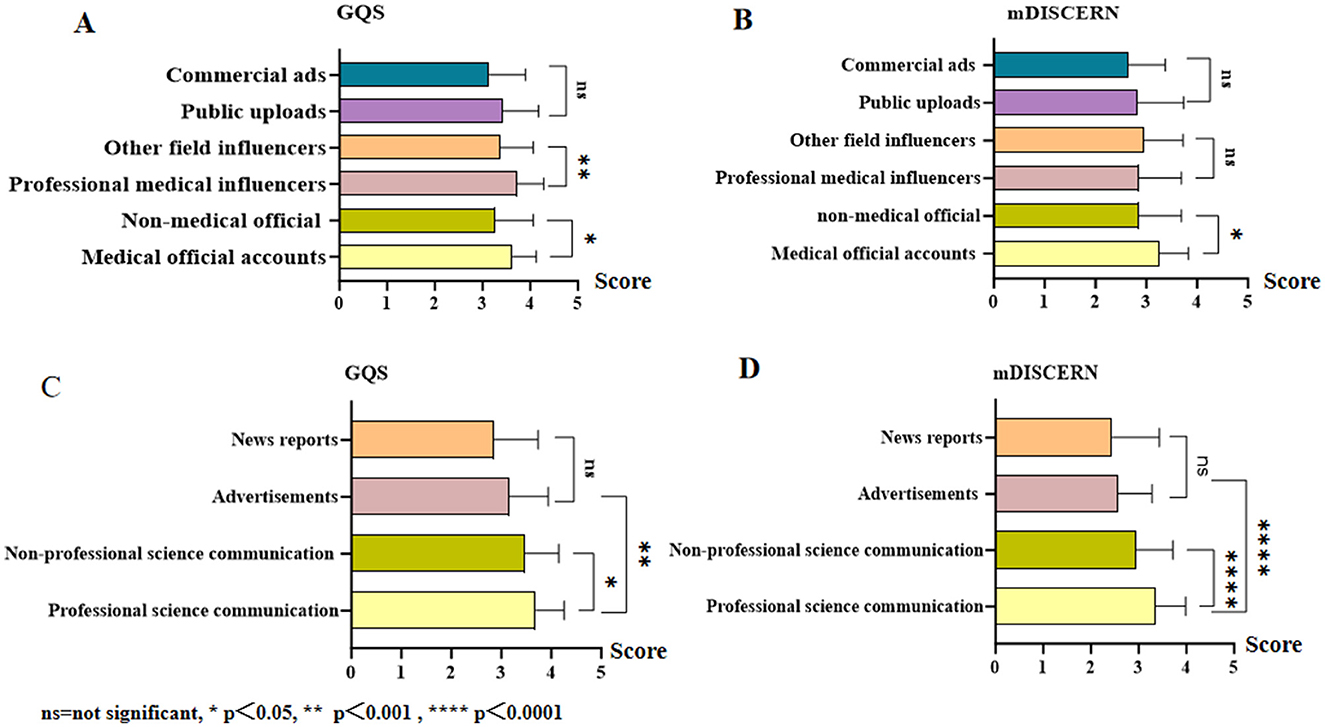
Figure 3. Panels A and B compare the distribution of GQS and mDISCERN scores for videos from different sources on Douyin and Bilibili; panels C and D compare the GQS and mDISCERN scores across different sources. ns, not significant, *p < 0.05; **p < 0.01; ****p < 0.0001.
Across platforms, the video quality of professional medical creators on Bilibili was higher than that on Douyin; however, the difference was not statistically significant. In terms of reliability, videos on Douyin outperformed those on Bilibili (p < 0.05; Figure 4).
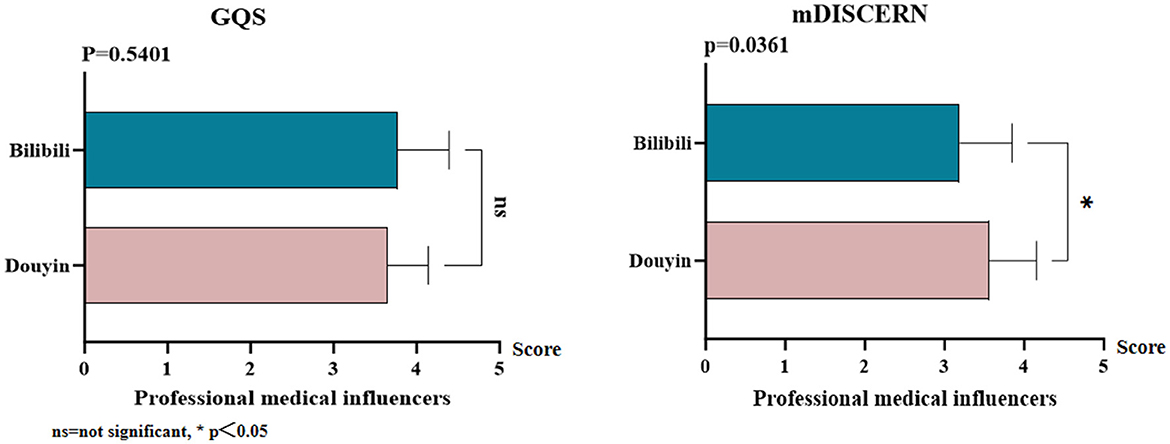
Figure 4. Comparison of Quality and Reliability Scores of Videos Published by Medical Professionals on Douyin and Bilibili.
3.4 Correlation analysis
We performed a Spearman correlation test to analyze the relationships between different variables across the two platforms (Figure 5). The following factors are strongly correlated on the Douyin platform: shares and saves (r = 0.963, p < 0.0001), likes and comments (r = 0.918, p < 0.0001), likes and shares (r = 0.905, p < 0.0001), likes and saves (r = 0.867, p < 0.0001), and comments and shares (r = 0.866, p < 0.0001). Moderate correlations were found between comments and saves (r = 0.781, p < 0.0001), GQS and mDISCERN (r = 0.713, p < 0.0001), mDISCERN and video length (r = 0.529, p < 0.0001). Weak correlations were observed between GQS and video length (r = 0.427, p < 0.0001). Very weak correlations were found between likes and followers (r = 0.176, p < 0.05). Negative correlations included comments and mDISCERN ($r = −0.173, p < 0.05), and video length and days since release (r = −0.169, p < 0.05).
On Bilibili, the following strong correlations were observed: comments and likes (r = 0.855, p < 0.0001), comments and saves (r = 0.814, p < 0.0001). Moderate correlations were found between shares and saves (r = 0.661, p < 0.0001), comments and shares (r = 0.568, p < 0.0001). Weak correlations were seen between GQS and mDISCERN (r = 0.483, p < 0.0001), video length and saves (r = 0.457, p < 0.0001), video length and mDISCERN (r = 0.356, p < 0.0001), video length and GQS (r = 0.351, p < 0.0001), video length and likes (r = 0.348, p < 0.0001), comments and followers (r = 0.332, p < 0.0001), and saves and followers (r = 0.331, p < 0.001). Very weak correlations were observed between shares and followers (r = 0.296, p < 0.0001), video length and comments (r = 0.290, p < 0.001), video length and shares (r = 0.284, p < 0.001), likes and followers (r = 0.274, p < 0.001), days since release and shares (r = 0.221, p < 0.01), shares and GQS (r = 0.220, p < 0.01), days since release and followers (r = 0.181, p < 0.05), and saves and GQS (r = 0.166, p < 0.05; Figure 5).
3.5 Release time and account verification
From 2019 onward, Bilibili initially had a higher number of video uploads than Douyin. However, after 2023, the number of videos uploaded on Douyin significantly surpassed that of Bilibili (Figure 6). Additionally, 62.67% of Douyin accounts are verified, while only 22% of Bilibili accounts are verified (Figure 7).
3.6 Video release locations
In mainland China, the provinces with the highest number of AED operation videos on Douyin were Guangdong (20 videos, 13.3%) and Beijing (20 videos, 13.3%). Other provinces with notable numbers included Shandong (10 videos, 6.7%), Jiangsu (10 videos, 6.7%), Zhejiang (8 videos, 5.3%), Hunan (6 videos, 4%), and Chongqing (6 videos, 4%). On Bilibili, Guangdong had the most videos (28 videos, 18.7%), followed by Beijing (15 videos, 10%), Shanghai (12 videos, 8%), Zhejiang (10 videos, 6.7%), Sichuan (9 videos, 6%), Henan (8 videos, 5.3%), and Jiangsu (8 videos, 5.3%). The release of AED operation educational videos was particularly prominent in Beijing and Guangdong. A small number of videos had their release locations hidden due to privacy settings. The distribution of video release locations is shown in Figures 8A, B.
4 Discussion
Driven by policy, the widespread adoption of AEDs has accelerated.2 At the same time, media coverage of successful AED rescues in public spaces and reports of influential public figures who suffered sudden cardiac arrest during large events and ultimately died due to the lack of timely CPR and AED use have drawn widespread public attention to AEDs' importance. Studies from Denmark, Singapore, and South Korea have shown that placing AEDs in public spaces and encouraging bystander use can significantly improve survival rates for cardiac arrest patients (16–18). When a sudden cardiac arrest occurs in a public space, bystanders who are proficient in using an AED to provide emergency care can offer critical life support to the patient before professional responders arrive. This helps fill the “time gap” in emergency care and significantly improves survival rates for cardiac arrest victims. With the continued rise of short-video platforms, the widespread dissemination of AED operation videos has become a key avenue for the public to learn first aid skills. An increasing number of individuals are gaining first-aid knowledge through these platforms.
4.1 Impact of video source and content on video quality and reliability
This cross-sectional study involved selecting 150 AED operation videos from Douyin and Bilibili. The quality and reliability of these videos were evaluated using the GQS and mDISCERN tools. Regarding video sources, videos published by professional medical influencers and medical official accounts had the highest quality, consistent with the findings of Gong et al. (19). Medical official videos had the highest content reliability, while the reliability of professional medical influencers' videos was lower than that of other field influencers. Both Douyin and Bilibili enforce strict professional standards for health-related content, ensuring that videos from professional medical influencers and medical official accounts meet high quality standards. Although videos from professional medical influencers are more authoritative compared to those from other field influencers, they tend to reference fewer valid content sources and mention less uncertainty, which resulted in lower reliability scores than those from other field influencers. However, commercial advertisements and non-medical official videos had lower GQS and mDISCERN scores, primarily due to their content being heavily focused on equipment usage, leading to content homogeneity.
When comparing professional medical influencers across the two platforms, Bilibili's AED operation videos had higher quality than those on Douyin, while the reliability of Douyin's professional medical influencers was higher than that of Bilibili's. Although both platforms have strict certification standards, Bilibili tends to prioritize interest-based certification, making Douyin appear more authoritative in this regard. However, Bilibili offers a more diverse approach to scientific communication. During our search, we found that some of Bilibili's science communication videos used animated formats, which are visually engaging and entertaining, making them more effective in stimulating audience interest.
Regarding content, professional science communication videos on AED operation received the highest GQS and mDISCERN scores. This indicates that professional science communication videos have advantages in terms of scientific accuracy, completeness, authority, and content quality. This underscores the importance of disseminating professional AED first-aid knowledge through short-video platforms. News reports, however, were considered to have lower quality and reliability compared to advertisements (20). News reports focus more on conveying event information and emphasizing news value, rather than providing clear and professional demonstrations as required for AED operation. News videos typically capture emergency scenes, while advertisements use high-quality visuals, clear demonstrations, and explanations to attract consumers, highlighting the product's advantages.
4.2 Correlation analysis among platform evaluation metrics
The analysis of user engagement behaviors on Douyin and Bilibili revealed significant platform-specific differences. On Douyin, likes, comments, shares, and saves were strongly interrelated (r = 0.963–0.866, p < 0.0001), indicating that one form of engagement often co-occurs with others. Moderate correlations were observed between comments and saves (r = 0.781), GQS and mDISCERN (r = 0.713), and mDISCERN and video duration (r = 0.529), suggesting partial alignment among these metrics. On Bilibili, comments were strongly correlated with likes and saves (r = 0.855–0.814) and moderately correlated among shares, comments, and saves (r = 0.661–0.568). However, GQS and mDISCERN were only weakly correlated (r = 0.483), indicating that higher video quality does not necessarily imply greater reliability. These findings demonstrate that user engagement behaviors, particularly likes, comments, and saves, are mutually reinforcing, consistent with previous studies (21), highlighting the importance of producing content that stimulates multidimensional interaction. For content creators, this underscores the need to focus on both video quality and reliability while enhancing engagement and shareability. For platform operators, understanding these interrelationships can help optimize recommendation algorithms to promote high-quality, highly interactive videos, thereby increasing overall user activity. For researchers, these patterns provide insights into how video characteristics and platform-specific dynamics influence engagement, offering guidance for the design and dissemination of health-related short videos.
4.3 Video release province
In mainland China, the promotion and popularization of AEDs show significant regional disparities. Beijing and Guangdong lead in AED deployment, education, and public awareness campaigns. Beijing has installed more than 7,000 AEDs, which are connected to a digital map integrated with the 120 emergency dispatch system, thus improving emergency response efficiency.3 Guangdong has installed more than 43,000 AEDs in public spaces, making it one of the highest AED-density cities in the country. The success of these regions' initiatives can be attributed to their high population density, significant demand for emergency care, strong economic development, and robust support from both the government and society.4 Research indicates that economically developed areas are the primary focus for AED deployment. High-income regions prioritize AED installation, as their economic conditions support the purchase and maintenance of AEDs (22).
In contrast, AED-related educational videos from Hong Kong and Macau are less frequently seen on mainland China's major social media platforms. These videos are primarily broadcast in Cantonese or other local languages, which, due to language and cultural differences, limits their widespread dissemination on platforms predominantly using Mandarin. In regions with low population densities, such as Tibet, Gansu, and Qinghai, AED education and promotion have been relatively slow. This is due to factors such as limited economic resources, sparse population distribution, geographical challenges, and low social attention, all of which result in fewer AED installation points, insufficient emergency facility configuration, and a lack of training resources.
4.4 Other findings
We observed from the comments and interactions that the public's primary concerns are legal risks and a lack of operational skills, especially among those without first aid training. A study conducted in the United States noted that, although legal protections for rescuers are provided across various states, some individuals still fear facing legal action for improper assistance. This concern is common across many countries and regions, including China (23). Despite the existence of laws in China that clearly state that “voluntary emergency assistance is not subject to civil liability,” the majority of people still lack the courage to intervene and offer help in emergencies.
However, the public engages in sharing first aid experiences and personal stories through comments and interactions, creating an atmosphere where everyone feels empowered to provide help in emergencies, such as sudden cardiac arrest (6). High-quality interactions also offer deeper insights into the public's specific needs regarding AED training, such as scenarios in which AEDs are used, whether everyone can operate them, how to quickly locate an AED in an emergency, and where on-site training can be accessed. Studies have shown that training and interactive discussions can strengthen the public's positive attitude toward performing emergency actions and reduce hesitation caused by legal concerns or a lack of skills (24). This practical training is something that cannot be fully replaced by merely watching educational videos (25). Therefore, in addition to disseminating AED operation educational videos, efforts should be made to raise public awareness of liability exemptions, alleviate legal concerns, and further enhance interactivity to increase public engagement and hands-on skills.
4.5 Limitations
This study is the first to analyze AED-related educational videos on China's two major short-video platforms, Douyin and Bilibili. Douyin has a broad user base, while Bilibili primarily targets a younger audience. The study avoided the limitations of cross-platform comparison. However, due to platform algorithms typically prioritizing high-traffic videos, there may be sample bias, potentially overlooking low-traffic yet high-quality videos (26). Some less-viewed but high-quality educational videos may have been inadvertently excluded, which could limit the generalizability of the findings to such content. The GQS and mDISCERN tools used in this study are effective for assessing video quality and reliability (27, 28); however, they rely on subjective judgments from raters (29). Furthermore, these tools may not be sufficiently sensitive in evaluating the finer details of AED operation and fail to account for the influence of video interactivity (e.g., comment discussions) on the effectiveness of information dissemination. Future research should incorporate multidimensional evaluation tools to more comprehensively assess the quality and impact of AED educational videos. In this study, inter-rater reliability (e.g., Cohen's kappa) was not calculated between the two emergency medicine reviewers for the GQS and mDISCERN assessments, which may increase the risk of subjective bias in the ratings and potentially affect the accuracy of subsequent statistical analyses. Future research should incorporate inter-rater reliability evaluation to enhance the objectivity of ratings and the robustness of data analysis.
4.6 Future trends and recommendations
As public health awareness rises and the demand for first aid knowledge increases (30, 31), short-video platforms have become an important channel for acquiring health information (32). Encouraging professional medical influencers and medical institutions to produce more high-quality AED educational videos is essential. At the same time, platforms should strengthen the review of AED-related content to ensure the accuracy and scientific validity of the information, while using algorithms to deliver AED educational content to individuals interested in first-aid knowledge. However, addressing public legal concerns is equally important.
5 Conclusion
The quality of AED educational videos on Douyin and Bilibili varies, with Bilibili generally offering higher quality content. Professional science communication videos, supported by medical background and practical experience, tend to have higher quality and reliability, providing the public with accurate, authoritative, and easily understandable AED knowledge. Moreover, a positive relationship was observed between video length and quality, as longer videos tend to provide more detailed content and lead to more impactful educational results. Effective interaction not only broadens the reach of AED educational videos but also enhances public confidence in emergency care. Regions such as Beijing and Guangdong, with their abundant medical resources, are leading in AED deployment and promotion, while the public's awareness of emergency care is gradually improving.
Looking ahead, we anticipate greater involvement from medical institutions and professional medical influencers in AED education. Platforms should also strengthen content review mechanisms to enhance the quality of educational materials. Moreover, encouraging the public to actively participate in practical training is crucial for improving first aid awareness and skills, thus fostering the widespread dissemination of AED knowledge.
Data availability statement
The original contributions presented in the study are included in the article/Supplementary material, further inquiries can be directed to the corresponding author.
Ethics statement
Ethical approval was not required for the study involving humans in accordance with the local legislation and institutional requirements. Written informed consent to participate in this study was not required from the participants or the participants' legal guardians/next of kin in accordance with the national legislation and the institutional requirements. This study utilized exclusively publicly accessible content from TikTok and Bilibili platforms, involving neither clinical data, biological specimens, nor laboratory animals. All collected data underwent rigorous de-identification protocols, institutional review board approval was waived given the observational nature of digital content analysis. The information collected in this study strictly adheres to the Terms of Service of both social media platforms. The TikTok User Agreement (Section 10: Intellectual Property Rights) and Bilibili Privacy Policy (Section 4.3: Information Disclosure and Interaction) explicitly state that user-uploaded video data is publicly accessible and permit its access and utilization. TikTok User Agreement: https://www.douyin.com/draft/douyin_agreement/douyin_agreement_user.html?ug_source=sem_baidu&id=6773906068725565448; Bilibili Privacy Policy: https://www.bilibili.com/blackboard/privacy-pc.html.
Author contributions
QL: Conceptualization, Data curation, Formal analysis, Investigation, Methodology, Visualization, Writing – original draft, Writing – review & editing. XD: Writing – original draft, Writing – review & editing. YJ: Writing – original draft, Resources, Formal analysis. DH: Data curation, Investigation, Writing – original draft. PW: Writing – original draft, Data curation, Investigation. XC: Data curation, Investigation, Methodology, Project administration, Resources, Supervision, Writing – original draft, Writing – review & editing, Validation.
Funding
The author(s) declare that financial support was received for the research and/or publication of this article. This work was funded by the 2023 Key Project of Science and Technology Communication and Popularization in Chongqing: “Popularization of High-Quality Cardiopulmonary Resuscitation Techniques and Standardized Use of AEDs in Universities” (Project No. cstc2023kpzx-kphdBX0068).
Conflict of interest
The authors declare that the research was conducted in the absence of any commercial or financial relationships that could be construed as a potential conflict of interest.
Generative AI statement
The author(s) declare that no Gen AI was used in the creation of this manuscript.
Any alternative text (alt text) provided alongside figures in this article has been generated by Frontiers with the support of artificial intelligence and reasonable efforts have been made to ensure accuracy, including review by the authors wherever possible. If you identify any issues, please contact us.
Publisher's note
All claims expressed in this article are solely those of the authors and do not necessarily represent those of their affiliated organizations, or those of the publisher, the editors and the reviewers. Any product that may be evaluated in this article, or claim that may be made by its manufacturer, is not guaranteed or endorsed by the publisher.
Supplementary material
The Supplementary Material for this article can be found online at: https://www.frontiersin.org/articles/10.3389/femer.2025.1604529/full#supplementary-material
Footnotes
1. ^https://www.globaltimes.cn/page/202408/1318873.shtml (Accessed March 5, 2025).
2. ^https://www.globaltimes.cn/page/202101/1211757.shtml (Accessed March 6, 2025).
3. ^https://english.beijing.gov.cn/latest/news/202408/t20240830_3785703.html (Accessed March 10, 2025).
4. ^https://global.chinadaily.com.cn/a/202101/08/WS5ff7c098a31024ad0baa1510.html (Accessed March 10, 2025).
References
1. Marijon E, Narayanan K, Smith K, Barra S, Basso C, Blom MT, et al. The Lancet Commission to reduce the global burden of sudden cardiac death: a call for multidisciplinary action. Lancet. (2023) 402:883–936. doi: 10.1016/S0140-6736(23)00875-9
2. Dreyfuss A, Carlson GK. Defibrillation in the cardiac arrest patient. Emerg Med Clin North Am. (2023) 41:529–42. doi: 10.1016/j.emc.2023.03.006
3. Tamirisa K, Patel H, Karim S, Mehta NK. Current landscape in US schools for bystander CPR training and AED requirements. J Interv Card Electrophysiol. (2023) 66:2177–82. doi: 10.1007/s10840-023-01579-9
4. Soar J, Becker LB, Berg KM, Einav S, Ma Q, Olasveengen TM, et al. Cardiopulmonary resuscitation in special circumstances. Lancet. (2021) 398:1257–68. doi: 10.1016/S0140-6736(21)01257-5
5. Zheng J, Lv C, Zheng W, Zhang G, Tan H, Ma Y, et al. BASIC-OHCA Coordinators and Investigators. Incidence, process of care, and outcomes of out-of-hospital cardiac arrest in China: a prospective study of the BASIC-OHCA registry. Lancet Public Health. (2023) 8:e923–32. doi: 10.1016/S2468-2667(23)00173-1
6. Tian X, Zhang Y, Dou D. Training experience is an important factor affecting willingness for bystander CPR and awareness of AED: a survey of residents from a province in Central China in 2023. Front Public Health. (2024) 12:1459590. doi: 10.3389/fpubh.2024.1459590
7. Zhang J, Yuan J, Zhang D, Yang Y, Wang C, Dou Z, et al. Short video platforms as sources of health information about cervical cancer: a content and quality analysis. PLoS ONE. (2024) 19:e0300180. doi: 10.1371/journal.pone.0300180
8. Gatewood J, Monks SL, Singletary CR, Vidrascu E, Moore JB. Social media in public health: strategies to distill, package, and disseminate public health research. J Public Health Manag Pract. (2020) 26:489–92. doi: 10.1097/PHH.0000000000001096
9. Xie Z, Li W, Xie Y, Wang L. Demand and satisfaction analysis of short health videos among Chinese urban youth: a mixed-methods study based on the KANO model. Humanit Soc Sci Commun. (2024) 11:740. doi: 10.1057/s41599-024-03266-0
10. Gong X, Chen M, Ning L, Zeng L, Dong B. The quality of short videos as a source of coronary heart disease information on TikTok: cross-sectional study. JMIR Form Res. (2024) 8:e51513. doi: 10.2196/51513
11. Libretti A, Vitale SG, Saponara S, Corsini C, Aquino CI, Savasta F, et al. Hysteroscopy in the new media: quality and reliability analysis of hysteroscopy procedures on YouTube™. Arch Gynecol Obstet. (2023) 308:1515–24. doi: 10.1007/s00404-023-07172-9
12. Liu H, Peng J, Li L, Deng A, Huang X, Yin G, et al. Assessment of the reliability and quality of breast cancer related videos on TikTok and Bilibili: cross-sectional study in China. Front Public Health. (2024) 11:1296386. doi: 10.3389/fpubh.2023.1296386
13. Silva EMM, Camargos CR, Pordeus IA, Abreu MHNG, Vargas-Ferreira F, Mattos FF. Global quality scores of Brazilian public health system-related YouTubeTM videos and their users' engagement. Braz Oral Res. (2024) 38:e099. doi: 10.1590/1807-3107bor-2024.vol38.0099
14. Guerini F, Caimi E, Laurelli F, Citro G, Danzi GB. Trusting the tube? YouTube®'s role in pacemaker patient and physician education. Int J Cardiol. (2024) 417:132591. doi: 10.1016/j.ijcard.2024.132591
15. Tezcan H, Akyildiz Tezcan E. Assessing the quality and reliability of cardiac rehabilitation information on YouTube: a systematic evaluation. Cureus. (2024) 16:e62752. doi: 10.7759/cureus.62752
16. Heo JY, Oh YT, Kim JH, Ahn C, Yang MS, Kim CW, et al. Association between bystander automated external defibrillator use and survival in witnessed out-of-hospital cardiac arrest: a nationwide observational study in South Korea. Resuscitation. (2024) 203:110388. doi: 10.1016/j.resuscitation.2024.110388
17. Sarkisian L, Mickley H, Schakow H, Gerke O, Starck SM, Jensen JJ, et al. Use and coverage of automated external defibrillators according to location in out-of-hospital cardiac arrest. Resuscitation. (2021) 162:112–9. doi: 10.1016/j.resuscitation.2021.01.040
18. Pourghaderi AR, Kogtikov N, Lees MH, Cai W, Pin Pek P, Fu Wah Ho A, et al. Maximum expected survival rate model for public access defibrillator placement. Resuscitation. (2022) 170:213–21. doi: 10.1016/j.resuscitation.2021.11.039
19. Gong X, Chen M, Ning L, Zeng L, Dong B. The quality of short videos as a source of coronary heart disease information on TikTok: cross-sectional study. JMIR Form Res. (2024) 8:e51513. doi: 10.2196/51513
20. Heuer H, Glassman EL. Reliability criteria for news websites. ACM Trans Comput-Hum Interact. (2024) 31:21. doi: 10.1145/3635147
21. Yang S, Brossard D, Scheufele DA, Xenos MA. The science of youtube: what factors influence user engagement with online science videos? PLoS ONE 17:e0267697. doi: 10.1371/journal.pone.0267697
22. Wu C, Wu Y, Qiao L. Revealing the decision-making practices in automated external defibrillator deployment: insights from Shanghai, China. BMC Public Health. (2025) 25:152. doi: 10.1186/s12889-025-21341-2
23. Murphy TW, Windermere S, Morris T, Slish J, Holtzman L, Becker TK. Risk and ROSC - Legal implications of bystander CPR. Resuscitation. (2020) 151:99–102. doi: 10.1016/j.resuscitation.2020.03.017
24. Liaw SY, Chew KS, Zulkarnain A, Wong SSL, Singmamae N, Kaushal DN, et al. Improving perception and confidence towards bystander cardiopulmonary resuscitation and public access automated external defibrillator program: how does training program help? Int J Emerg Med. (2020) 13:13. doi: 10.1186/s12245-020-00271-3
25. Tarchi C, Zaccoletti S, Mason L. Learning from text, video, or subtitles: a comparative analysis. Comput Educ. (2021) 160:104034. doi: 10.1016/j.compedu.2020.104034
26. Leong AY, Sanghera R, Jhajj J, Desai N, Jammu BS, Makowsky MJ. Is YouTube useful as a source of health information for adults with type 2 diabetes? A South Asian perspective. Can J Diabetes. (2018) 42:395–403.e4. doi: 10.1016/j.jcjd.2017.10.056
27. Erdogan A, Kaya E, Sahin M, Kurt B, Gökmen R. The quality and reliability of information in YouTube videos on occupational health and safety. Indian J Occup Environ Med. (2024) 28:71–6. doi: 10.4103/ijoem.ijoem_263_23
28. Ozdemir ZM, Yavuz SA, Gursel Surmelioglu D. YouTube as an information source in deep margin elevation: reliability, accuracy and quality analysis. PLoS ONE. (2025) 20:e0318568. doi: 10.1371/journal.pone.0318568
29. Sahin E, Seyyar M. Assessing the scientific quality and reliability of YouTube videos about chemotherapy. Medicine. (2023) 102:e35916. doi: 10.1097/MD.0000000000035916
30. Khatri RB, Endalamaw A, Erku D, Wolka E, Nigatu F, Zewdie A, et al. Preparedness, impacts, and responses of public health emergencies towards health security: qualitative synthesis of evidence. Arch Public Health. (2023) 81:208. doi: 10.1186/s13690-023-01223-y
31. Lee JM, Jansen R, Sanderson KE, Guerra F, Keller-Olaman S, Murti M, et al. Public health emergency preparedness for infectious disease emergencies: a scoping review of recent evidence. BMC Public Health. (2023) 23:420. doi: 10.1186/s12889-023-15313-7
Keywords: automated external defibrillator, video, cross-sectional study, health education, quality evaluation
Citation: Luo Q, Deng X, Jiang Y, Hu D, Wang P and Chen X (2025) Reliability and quality assessment of AED-related videos on Douyin and Bilibili: a cross-sectional study from China. Front. Disaster Emerg. Med. 3:1604529. doi: 10.3389/femer.2025.1604529
Received: 02 April 2025; Accepted: 20 August 2025;
Published: 09 September 2025.
Edited by:
Patrick Van De Voorde, Ghent University Hospital, BelgiumReviewed by:
Ezgi Akyildiz Tezcan, Selcuk University, TürkiyeIskender Aksoy, Giresun University, Türkiye
Copyright © 2025 Luo, Deng, Jiang, Hu, Wang and Chen. This is an open-access article distributed under the terms of the Creative Commons Attribution License (CC BY). The use, distribution or reproduction in other forums is permitted, provided the original author(s) and the copyright owner(s) are credited and that the original publication in this journal is cited, in accordance with accepted academic practice. No use, distribution or reproduction is permitted which does not comply with these terms.
*Correspondence: Xiaoxiong Chen, Y2hlbnh4QHRtbXUuZWR1LmNu
 Qiuyue Luo
Qiuyue Luo Xiaolu Deng1
Xiaolu Deng1